Achromatic Doublet Pairs, AR Coated: 650 - 1050 nm
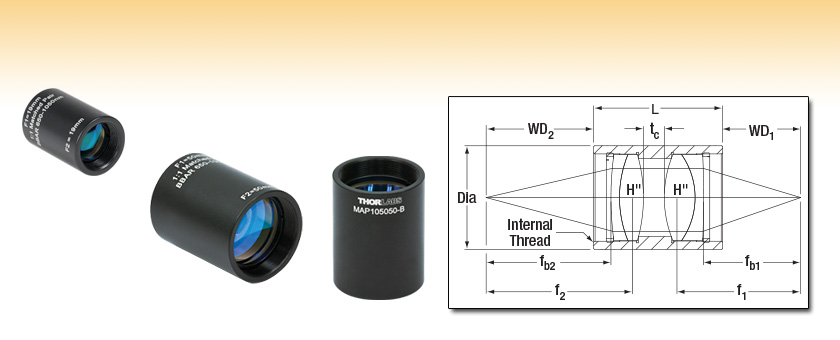
- Broadband AR Coating for 650 - 1050 nm
- SM05- or SM1-Threaded Housing
- Mounts Engraved with Focal Lengths and Magnification
MAP051919-B
MAP105050-B

Please Wait
| General Specifications | |
|---|---|
| Design Wavelengths | 706.5, 855, and 1015 nm |
| Focal Length Tolerance | ±1% |
| Reflectance (650 - 1050 nm) | Ravg < 0.5% |
| Click on the red Document icon next to the item numbers below to access the Zemax file download. Our entire Zemax Catalog is also available. |
Features
- Available with Antireflection Coating for 400 - 700 nm or 650 - 1050 nm
- Ideal for Image Relay, NA Conversion, or Image Magnification
- Different Magnifications for Imaging and Numerical Aperture Matching
- Focal Lengths Clearly Marked for Quick Identification
- Compatible with Thorlabs' SM05- or SM1-Threaded Components
Thorlabs' Matched Achromatic Pairs combine two of our unmounted, cemented achromatic doublets for image relay, NA conversion, or image magnification. Achromatic doublets are designed for infinite conjugate ratios, but are ideal for finite conjugate applications when used in pairs. In finite conjugate applications, both the object and image are a finite distance from the lens pair.
These pairs are housed in SM05 (0.535"-40) or SM1 (1.035"-40) threaded housings, which have outer diameters of Ø0.7" and Ø1.2", respectively. The housing is engraved with the part number, focal lengths, and magnification of the pair, allowing for easy identification. Since the lenses are pre-mounted, there is no need to handle the glass optics, making these achromats ideal for integration into a host of OEM applications.
To achieve the specified magnification, orient the mount so that the end of the housing with the shorter focal length lens is closer to the object. If the lens is used in the reverse direction, the inverse magnification will be achieved. If the two lenses have the same focal length, either orientation of the housing will produce 1:1 magnification.
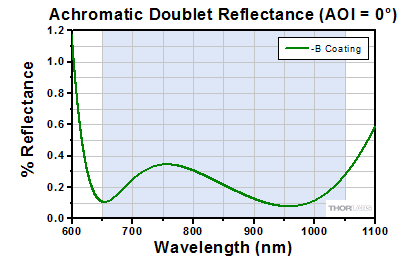
Click to Enlarge
Click Here for Raw Data
Figure 1.1 The shaded region indicates the specified 650 - 1050 nm wavelength range for optimum performance.
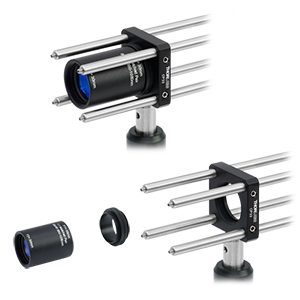
Click for Details
Figure 1.2 Ø1" Achromatic Doublet Pair Mounted in a CP33 Cage Plate using an SM1T2 Adapter
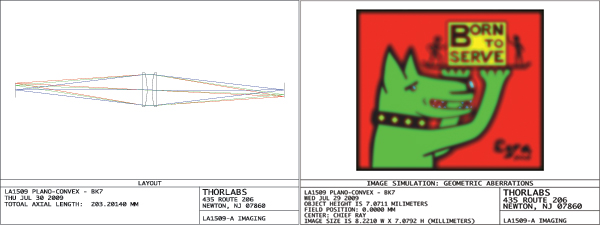
Figure 2.1 LA1509-A Pair
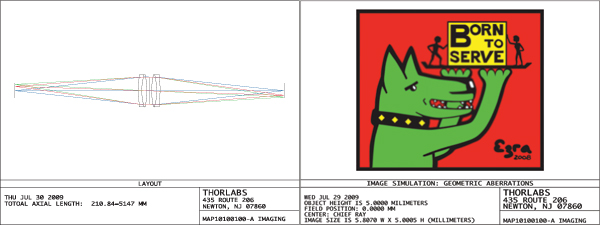
Figure 2.2 MAP10100100-A Pair
The matched Achromatic Pairs offer superior performance in a simplified package compared to traditional spherical singlets when used for image relay. In the first set of plots (Figure 2.1), two LA1509-A N-BK7 plano-convex lenses are optimized to image the Thorlabs logo. In the second set of plots (Figure 2.2), the MAP10100100-A is used to image the logo, and the improvement is obvious. The doublet pair in the MAP configuration is able to minimize the spherical and chromatic aberrations to produce a better image.
| Posted Comments: | |
Alejandro Martinez Jimenez
(posted 2024-08-14 15:10:10.937) Hi,
I'm contacting you about the achromat pairs. They are a really interesting option, and quite useful. However, when using them for imaging, a lot of people will benefit if you place an iris exactly on the focal plane. When your beam is quite large the aberrations are huge, this can always be minimized with a pinhole that you already have in SM05. So maybe incorporating it into your achromat pair would be a good idea.
Best regards cdolbashian
(posted 2024-08-16 04:05:53.0) Thank you for reaching out to us regarding your inquiry. I have contacted you directly so that you can share some performance data with us, as well as discuss the proffered suggestion for improving imaging performance. This kind of feedback is useful for us to improve our product performance and presentation. Blanca Ruiz
(posted 2021-06-11 07:50:09.277) Hi, do you have these achromatic pairs for the IR/ C line?
I need something that will work at 1300nm.
If not, how will MAP1050100-B perform at 1300nm? I am using it to relay beam to an beam profiler. cdolbashian
(posted 2021-07-12 11:17:21.0) Thank you for contacting us here at Thorlabs! While we do not have matched pairs explicitly designed at this wavelength, it's very likely we could help you select a pair of individual achromats, and an appropriate housing to create a matched pair at your wavelength of choice. Regarding the use of the MAP1050100-B at your wavelength, you will run into issues with transmission, back reflections, and focal length shift. I have reached out to you directly to discuss the details of your application. Joseph Chapman
(posted 2020-09-09 08:40:56.68) On the website, the Theoretical Transmission info pop out points to the -A version not the -B version YLohia
(posted 2020-09-09 02:01:48.0) Hello, thank you for your feedback and bringing this to our attention. We are working on fixing this. cohennc
(posted 2017-07-06 06:03:06.89) Hi why you do not do new product 1:1.5 Achromatic Doublet Pairs 40mm/60mmfor diode pump lasers
this is better than 50/75mm.
fibers of diode laser are N.A.=0.22. 2 x N.A. is ~ the F# of 1"/50mm~0.25 almost the N.A.
the clear aperture is not 100% so this is very limited.
thanks tfrisch
(posted 2017-08-04 02:30:40.0) Hello, thank you for contacting Thorlabs. With a clear aperture of >90%, the NA would be roughly 0.23 which should be well matched. However, I will reach out to you directly to discuss your application and the possibility of a 40mm/60mm system. christian.maibohm
(posted 2017-04-03 10:12:29.35) Dear Thorlabs,
I am building a scanning microscope and will use a NIR Achromatic Doublet Pairs (M=1) as a relay lens system between the scanning mirrors. Should I place the scanning mirrors exactly at the focal distance of the NIR Achromatic Doublet Pairs or can I choose an arbitrary distance as long as it is the same for both mirrors (the laser is collimated)? I would like to minimize the distance so I am able to scan larger deflection angles of the mirrors. Best regards, Christian Maibohm tfrisch
(posted 2017-05-04 12:01:17.0) Hello, thank you for contacting Thorlabs. I will reach out to you directly about this application, but typically the focus of a scan lens is between the scanning mirrors. mtbernucci
(posted 2016-02-23 13:46:07.623) I had a question about the achromatic doublet pairs, specifically about the distance between the lenses tc. How is this distance determined or optimized for two achromatic doublets with the same focal length? And what are the benefits of separating the two lenses instead of having them touch?
Thank you.
Marcel besembeson
(posted 2016-03-08 11:57:06.0) Response from Bweh at Thorlabs USA: Our designs are optimized in Zemax based on performance requirements and housing constraints. Separating the lenses simply avoids the chance of damaging any of the lenses due to touching, especially if you are not bonding with some suitable optical epoxy. With achromats of same focal length, you can adjust the distance as guided by the available space in your setup. patric.oulevey
(posted 2016-01-22 18:18:33.287) Hello,
I'd like to expand a laser beam by roughly 10x. I thought I could use two of the 1:3.33 Doublet pairs in a row. Is that correct?
I'm not sure if one such doublet pair expands a beam (focus at infinity) by 3.33, or if I misunderstood and I'd need four doublet pairs in total.
best, Patric besembeson
(posted 2016-02-01 09:28:24.0) Response from Bweh at Thorlabs USA: These are designed for image relay, and not beam expansion. We have a good selection of beam expanders that will be suitable for your application at the following link: http://www.thorlabs.com/navigation.cfm?guide_id=2023 |



 Products Home
Products Home








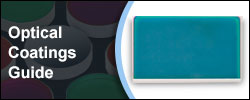
 NIR Achromatic Doublet Pairs
NIR Achromatic Doublet Pairs